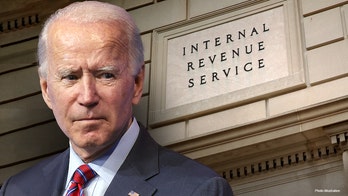Growing concerns in West over federal land grab
Alicia Acuna reports from Colorado National Monument
Utah officials are scrambling to prevent the Obama administration from locking down thousands of acres of land in their backyard, as federal officials consider up to a dozen possible national monument designations – all in western states.
The Antiquities Act gives U.S. presidents the authority to unilaterally declare public lands as national monuments at the stroke of a pen, with no input from the public unless they choose to seek it.
Many national monuments eventually go on to become national parks.
National Parks Conservation Association spokeswoman Kristen Brengel said the practice has been used for over a century to preserve some of America’s most iconic landmarks: including the Grand Canyon, the Statue of Liberty and Arches National Park.
“It's a wonderful tool to conserve these resources so that people can enjoy them in perpetuity,” she said.
But critics feel the Antiquities Act has been misused in recent decades by presidents of both parties and, in Utah, they’re seeking a compromise that would allow some land to become designated as “wilderness” instead.
"The original Antiquities Act passed as a way of conserving land," Republican Utah Rep. Rob Bishop said. "It's no longer used that way. Now it's used as a political purpose to make a political statement on land that is not endangered in any way."
The issue is particularly sensitive in the American West, where the vast majority of federally owned and controlled land lies.
"In the West, almost half of the land, versus 4 percent in the East, is owned by the federal government," Bishop said. "So in my state of Utah, 70 percent is owned and controlled by the federal government. So we in the West clearly see this differently, because we face it and live with it every day."
A draft Interior Department memo in 2010 suggested 12 sites for possible national monument designation by President Obama. The land already is mostly in federal hands, but a monument designation would more tightly restrict access.
All of the sites are in the West, including Organ Mountains-Desert Peaks in New Mexico, which President Obama declared a new national monument in May.
Four of the other 11 sites in the Interior memo are in the state of Utah. Recently, 14 U.S. senators wrote to Obama urging him to declare a Greater Canyonlands monument in Utah. None of the senators live in the Intermountain West, much less the state of Utah, where anger over a previous national monument designation is still palpable.
Utah Gov. Gary Herbert recalled how then-President Clinton designated the Grand Staircase-Escalante National Monument in southern Utah, by far the nation's largest, covering an area the size of Delaware and Rhode Island combined.
"President Clinton in 1996 -- denying that he was going to do it without any input from our congressional delegation or local government or state government -- just one day announced this designation,” Herbert said.
Bishop said “there were so many problems with it that were never solved when it was created.”
"They were never solved because it was a simplistic overreach and you didn't go into the details,” he said.
Emery County Commissioner Ethan Migliori said the monument is still a “bitter conversation in Utah.”
The problem, Migliori said, is the designation effectively “shut down everything” in that area.
“You can't access it anymore ... even on designated roads,” Migliori said.
Brengel said this president won't declare national monuments without warning. "One of the main things that the Obama administration has said is that they are looking for local input. Not just from local leaders but also from the public,” Brengel said.
Not willing to wait and see, Bishop has proposed a public lands initiative to work out a compromise. Instead of becoming national monuments, some land would become protected wilderness areas while allowing development on the rest.
Migliori and other officials in Emery County, where 92 percent of the land is owned by the federal government, support Bishop's efforts wholeheartedly. The proposed San Rafael National Monument would take up nearly 1,000 square miles, almost all of it in Emery County.
"It appears you have more access to a national park than you do to a national monument," Migliori said. "So a national monument is almost a death wish, or it feels like that to us."
Several environmental groups are also taking part in the discussions. "We are willing to work with any member of Congress on these proposals. We understand that their constituents have various interests. Ours in particular would be to protect some areas as wilderness or national parks,” Brengel said.
Herbert is also on board, saying: "The environmental community, industry, local civic and business leaders, farmers, ranchers, energy developers … All of the above come together and talk about what areas need to be developed and how, and what areas need to be preserved and protected because of their iconic vistas and venues."
Bishop said Interior Secretary Sally Jewell has spoken to him twice about his public lands initiative. "The secretary of Interior is encouraging us to move forward in doing it this way because it's a much more satisfactory process than ever it would be if you used the Antiquities Act,” he said.





